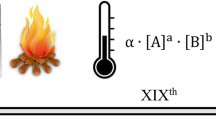Abstract
Lavoisier defined an element as a chemicalsubstance that cannot be decomposed usingcurrent analytical methods. Mendeleev saw anelement as a substance composed of atoms of thesame atomic weight. These `definitions' doquite different things: Lavoisier'sdistinguishes the elements from the compounds,so that the elements may form the basis of acompositional nomenclature; Mendeleev's offersa criterion of sameness and difference forelemental substances, while Lavoisier's doesnot. In this paper I explore the historical andtheoretical background to each proposal.Lavoisier's and Mendeleev's explicitconceptions of elementhood differed from eachother, and from the official IUPAC definitionof `element' of the 1920s. However, Lavoisierand Mendeleev both subscribed to – andemployed – a deeper notion of a chemicalelement as the component of compound substancesthat (i) can survive chemical change, and (ii)explains the chemical behaviour of itscompounds.
Similar content being viewed by others
REFERENCES
B. Bensaude-Vincent, L'éther, élément chimique: un essai malheureux de Mendeleev? British Journal for the History of Science 15: 183–188, 1982.
B. Bensaude-Vincent. Mendeleev's Periodic System. British Journal for the History of Science 19: 3–17, 1986.
W.H. Brock. Fontana History of Chemistry. London: Fontana Press, 1992.
S. Brush. The Reception of Mendeleev's Periodic Law in America and Britain. Isis 87: 595–628, 1996.
H. Cassebaum and G. Kauffman. The Analytical Concept of a Chemical Element in the Work of Bergman and Scheele. Annals of Science 33: 447–456, 1976.
M. Crosland. Changes in Chemical Concepts and Language in the Seventeenth Century. Science in Context 9: 225–240, 1996.
M. Devitt and K. Sterelny. Language and Reality, 2nd edn. Oxford: Blackwell, 1999.
A. Donovan. Antoine Lavoisier: Science, Administration and Revolution. Cambridge: Cambridge University Press, 1993.
J. Dupré. The Disorder of Things. Cambridge, MA: Harvard University Press, 1993.
M. Gordin. Making Newtons: Mendeleev, Metrology and the Chemical Ether. Ambix 45: 96–115, 1998.
J.B. Gough. The Origins of Lavoisier's Theory of the Gaseous State. In H. Woolf (Ed.), The Analytic Spirit. Ithaca: Cornell University Press, 1981.
I. Hacking. Representing and Intervening. Cambridge: Cambridge University Press, 1983.
R.F. Hendry.What Chemical Kinds Have to Do. In preparation (forthcoming).
J. Hudson. The History of Chemistry. London: Macmillan, 1992.
A. Lavoisier. Traité Elémentaire de Chimie, 1789. Page references are to the translation by Robert Kerr as The Elements of Chemistry. Edinburgh: William Creech, 1790; <nt>reprinted as D.M. Knight (Ed.), The Development of Chemistry, Volume 2. Routledge: Thoemmes Press, 1998. </nt>
H.E. Le Grand. Lavoisier's Oxygen Theory of Acidity. Annals of Science 29: 1–18, 1972.
H.E. Le Grand. Ideas on the Composition of Muriatic Acid and Their Relevance to the Oxygen Theory of Acidity. Annals of Science 31: 213–225, 1974.
J. McEvoy. Continuity and Discontinuity in the Chemical Revolution. Osiris 4: 195–213, 1988.
D.I. Mendeleev. The Relation between the Properties and Atomic Weights of the Elements. Journal of the Russian Chemical Society 1: 60–77, 1869. Page references are to the translation in Henry M. Leicester and Herbert S. Klickstein (Eds.), <nt>A Source Book in Chemistry 1400-1900, pp. 439-442. Harvard University Press, 1952. </nt>
D.I. Mendeleev. The Periodic Law of the Chemical Elements. The Chemical News XL: 267–268, 1879; reprinted in D.M. Knight (Ed.), <nt>Classical Scientific Papers-Chemistry, 2nd Series. London: Mills and Boon, 1970. </nt>
D.I. Mendeleev. The Periodic Law of the Chemical Elements. Journal of the Chemical Society 55: 634–656, 1889; reprinted in D.M. Knight (Ed.), <nt>Classical Scientific Papers-Chemistry, 2nd Series. London: Mills and Boon, 1970. </nt>
F.A. Paneth. The Epistemological Status of the Chemical Concept of Element (II). British Journal for the Philosophy of Science 13: 144–160, 1962.
C.E. Perrin. Lavoisier's Table of the Elements: A Reappraisal. Ambix 20: 95–105, 1973.
R. Siegfried. Lavoisier's Table of Simple Substances: Its Origin and Interpretation. Ambix 29: 29-48, 1982.
R. Siegfried and B.J. Dobbs. Composition, a Neglected Aspect of the Chemical Revolution. Annals of Science 24: 275–293, 1968.
P.K. Stanford and P. Kitcher. Refining the Causal Theory of Reference for Natural Kind Terms. Philosophical Studies 97: 99–129, 2000.
Rights and permissions
About this article
Cite this article
Hendry, R.F. Lavoisier and Mendeleev on the Elements. Foundations of Chemistry 7, 31–48 (2005). https://doi.org/10.1023/B:FOCH.0000042886.65679.4e
Issue Date:
DOI: https://doi.org/10.1023/B:FOCH.0000042886.65679.4e




